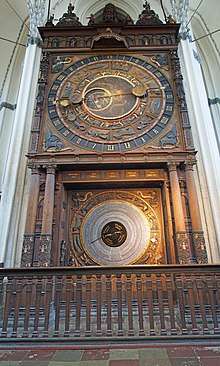Rostock astronomical clock
The Rostock astronomical clock is a fifteenth-century astronomical clock in St. Mary's Church, Rostock.

Rostock Astronomical Clock
History and description
The astronomical clock was built in 1472[1] by Hans Düringer, a clockmaker from Nuremberg. It consists of three partitions:
- Top: Apostle-go-round giving an hourly performance of the apostles crossing before Jesus for a blessing before entry into eternal bliss, and the last, Judas, is shut out.
- Middle: Clock with daily time, zodiac, moon phases, and month;
- Bottom: Calendar, which is valid until 2150 (with beginning of 2018 this table replaced the 4th, which lasted from 1885 to 2017).[2]
The medieval clock is the only one of its kind still in working condition with its original clockworks.[3]
gollark: Very simple autocrafting *is* doable without huge problems - Dragon had an implementation - but that's not very good.
gollark: Are you suggesting we should cover anything but the maximally general case? HERESY!
gollark: In fact, not only is it computationally NP-hard, apparently (Squid did some insanity here: https://squiddev.cc/2018/01/28/ae-sat.html), but to do it *well* you also have to somehow make highly subjective decisions!
gollark: Auto-crafting turns out to be extremely hard.
gollark: Probably, but it would likely only work within Opus OS.
References
- Europe on a shoestring. Vivek Wagle. 2003. ISBN 1740593146
- "THE ASTRONOMICAL CLOCK OF THE ST.-MARIEN-KIRCHE IN ROSTOCK" (PDF). www.astronomischeuhr.de.
- Repository for the Rostock Astronomical Clock
This article is issued from Wikipedia. The text is licensed under Creative Commons - Attribution - Sharealike. Additional terms may apply for the media files.